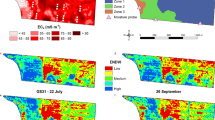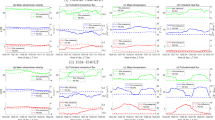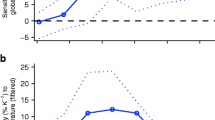Abstract
A method is proposed to estimate the threshold wind speed for dust emissions as a function of soil moisture in arid regions. This method, which is applicable at the local scale, employs a model of the surface heat budget to estimate the spatial distribution of thermal inertia-derived soil moisture (TISM) and an analytical footprint model to estimate dust source areas. It incorporates readily available satellite and meteorological data. The soil moisture inside the dust source area is estimated for individual dust phenomena observed at a synoptic surface observation site, and then, together with the corresponding observed wind speed, the threshold wind speed as a function of soil moisture is found by employing the parametrization of Fécan et al. (Ann Geophys 17:149–157, 1999). This relationship represents the local dust climatology at the observation site, although the data include some outliers. The results show that readily available data for the natural environment can be used, as an alternative to wind-tunnel data, with the parametrization used to derive the threshold wind-speed relation. The derived relation indicates the TISM and wind speed at which the probability of a dust phenomenon is 10%. Moreover, the threshold wind-speed results are not sensitive to the principal footprint-model parameters. The TISM standard error of approximately 0.04 m3 m−3 could significantly affect the results under dry and weak-wind conditions, but this sensitivity can be avoided if the soil clay content or the soil type at the observation point is known.










Similar content being viewed by others
References
Belly PY (1964) Sand movement of wind. U.S. Army Corps of Engineers, Coastal Engineering Research Center. Tech. Memo No. 1, Washington DC, p 38
Bisal F, Hsieh J (1966) Influence of moisture on erodibility of soil by wind. Soil Sci 102:143–146
Chen W, Zhibao D, Zhenshan L, Zuotao Y (1996) Wind tunnel test of the influence of moisture on the erodibility of loessial sandy loam soils by wind. J Arid Environ 34:391–402
Fécan F, Marticorena B, Bergametti G (1999) Parametrization of the increase of the aeolian erosion threshold wind friction velocity due to soil moisture for arid and semi-arid areas. Ann Geophys 17:149–157
Gantsetseg B, Ishizuka M, Kurosaki Y, Mikami M (2017) Topographical and hydrological effects on meso-scale vegetation in desert steppe, Mongolia. J Arid Land 9:132–142
Ishizuka M, Mikami M, Yamada Y, Zeng F, Gao W (2005) An observational study of soil moisture effects on wind erosion at a gobi site in the Taklimakan Desert. J Geophys Res 110:D18S03
Ishizuka M, Mikami M, Yamada Y, Zeng F (2009) Threshold friction velocities of saltation sand particles for different soil moisture conditions in the Taklimakan Desert. SOLA 5:184–187
Ishizuka M, Mikami M, Yamada Y, Kimura R, Kurosaki Y, Jugder D, Gantsetseg B, Cheng Y, Shinoda M (2012) Does ground surface soil aggregation affect transition of the wind speed threshold for saltation and dust emission? SOLA 8:129–132
Kawamura H, Takahashi S, Takahashi T (1998) Estimation of insolation over the Pacific Ocean off the Sanriku Coast. J Oceanogr 54:457–464
Khishigbayar J, Fernandez-Gimenez ME, Angerer JP, Reid RS, Chantsallkham J, Ya Baasandorj, Zumberelmaa D (2015) Mongolian rangelands at a tipping point? Biomass and cover are stable but composition shifts and richness declines after 20 years of grazing and increasing temperatures. J Arid Environ 115:100–112
Kikuchi T, Kitsuregawa M (2000) Kochi University Weather Home: a satellite image distribution system utilizing the internet. IPSJ SIG Technical Report 69:223–228
Kimura R, Abulaiti A, Mano M, Matsushima D (2016) Surface heat flux analysis in Gobi Desert steppe, Mongolia—an observation study. SOLA 12:175–180
Kljun N, Kormann R, Rotach MW, Meixner FX (2003) Comparison of the lagrangian footprint model LPDM-B with an analytical footprint model. Boundary-Layer Meteorol 106:349–355
Kljun N, Calanca P, Rotach MW, Schmid HP (2015) A simple two-dimensional parameterisation for flux footprint prediction (FFP). Geosci Model Dev 8:3695–3713
Kondo J, Nakamura T, Yamazaki T (1991) Estimation of the solar and downward atmospheric radiation. Tenki 38:41–48 (in Japanese with English abstract)
Kormann R, Meixner FX (2001) An analytical footprint model for non-neutral stratification. Boundary-Layer Meteorol 99:207–224
Kurosaki Y, Mikami M (2007) Threshold wind speed for dust emission in east Asia and its seasonal variations. J Geophys Res 112:D17202
Kurosaki Y, Shinoda M, Mikami M (2011) What caused a recent increase in dust outbreaks over East Asia? Geophys Res Lett 38:L11702
Ma AN, Xue Y (1990) A study of remote sensing information model of soil moisture. In: 11th Asian conference on remote sensing, Beijing, China
Matsushima D, Asanuma J, Kaihotsu I (2017) Variations in the relation between thermal inertia and soil moisture content with regard to the soil types as a parameter. Proc Soil Moisture Workshop 2016:13–17 (in Japanese)
Matsushima D, Asanuma J, Kaihotsu I (2018) Thermal inertia approach using a heat budget model to estimate the spatial distribution of surface soil moisture over a semiarid grassland in Central Mongolia. J Hydrometeorol 19:245–265
McKenna-Neuman C, Nickling WG (1989) A theoretical and wind tunnel investigation of the effect of capillary water on the entrainment of sediment by wind. Can J Soil Sci 69:79–96
Myneni R, Knyazikhin Y, Park T (2015) MCD15A2H MODIS/Terra+Aqua Leaf Area Index/FPAR 8-day L4 Global 500 m SIN Grid V006. distributed by NASA EOSDIS Land Processes DAAC (https://lpdaac.usgs.gov). Accessed 22 Oct 2018. https://doi.org/10.5067/modis/mcd15a2h.006
Nandintsetseg B, Shinoda M, Erdenetsetseg B (2017) Contributions of multiple climate hazards and overgrazing to the 2009/2010 winter disaster in Mongolia. Nat Hazard. https://doi.org/10.1007/s11069-017-2954-8
Nelder JA, Mead R (1965) A simplex method for function minimization. Comput J 7:308–313
Noilhan J, Planton S (1989) A simple parameterization of land surface processes for meteorological models. Mon Weather Rev 117:536–549
Ohtani S, Onishi K, Kurozawa Y, Kurosaki Y, Bat-Oyun T, Shinoda M, Mu H (2016) Assessment of the effects of severe winter disasters (Dzud) on public health in Mongolia on the basis of loss of livestock. Disast Med Publ Health Prep 10:549–552
Pratt DA, Ellyett CD (1979) The thermal inertia approach to mapping of soil moisture and geology. Remote Sens Environ 8:151–168
Saleh A, Fryrear DW (1995) Threshold wind velocities of wet soils as affected by wind blown sand. Soil Sci 160:304–309
Schaaf C, Wang Z (2015) MCD43A3 MODIS/Terra+Aqua BRDF/Albedo Daily L3 Global—500 m V006. distributed by NASA EOSDIS Land Processes DAAC (https://lpdaac.usgs.gov). Accessed 22 Oct 2018. https://doi.org/10.5067/modis/mcd43a3.006
Scheidt S, Ramsey M, Lancaster N (2010) Determining soil moisture and sediment availability at White Sands Dune Field, New Mexico, from apparent thermal inertia data. J Geophys Res Earth Surf 115:F02019
Schmid HP (1994) Source areas for scalars and scalar fluxes. Boundary-Layer Meteorol 67:293–318
Shao Y (2008) Physics and modelling of wind erosion, 2nd revised and expanded edn. Springer, Netherlands, p 456
Shao Y, Mikami M (2005) Heterogeneous saltation: theory, observation and comparison. Boundary-Layer Meteorol 115:359–379
Shao Y, Yang Y, Wang J, Song Z, Leslie LM, Dong C, Zhang Z, Lin Z, Kanai Y, Yabuki S, Chun Y (2003) Northeast Asian dust storms: real-time numerical prediction and validation. J Geophys Res 108:4691–4708
Sharratt BS, Vaddella VK, Feng G (2013) Threshold friction velocity influenced by wetness of soils within the Columbia Plateau. Aeolian Res 9:175–182
Shinoda M, Kimura R, Mikami M, Tsubo M, Nishihara E, Ishizuka M, Yamada Y, Munkhtsetseg E, Jugder D, Kurosaki Y (2010) Characteristics of dust emission in the Mongolian Steppe during the 2008 DUVEX intensive observational period. SOLA 6:9–12
Smith A, Lott N, Vose R (2011) The integrated surface database: recent developments and partnerships. Bull Am Meteorol Soc 92:704–708
Stull RB (1988) An introduction to boundary layer meteorology, 2nd edn. Springer, Netherlands, p 670
Vesala T, Kljun N, Rannik U, Rinne J, Sogachev A, Markkanen T, Sabelfeld K, Foken Th, Leclerc MY (2008) Flux and concentration footprint modelling: state of the art. Environ Pollut 152:653–666
Wan Z, Hook S, Hulley G (2015a) MYD11_L2 MODIS/Aqua Land Surface Temperature/Emissivity 5-Min L2 Swath 1 km V006. distributed by NASA EOSDIS LP DAAC (https://lpdaac.usgs.gov). Accessed 22 Oct 2018. https://doi.org/10.5067/modis/myd11_l2.006
Wan Z, Hook S, Hulley G (2015b) MOD11_L2 MODIS/Terra Land Surface Temperature/Emissivity 5-Min L2 Swath 1 km V006. distributed by NASA EOSDIS LP DAAC (https://lpdaac.usgs.gov), Accessed 22 Oct 2018. https://doi.org/10.5067/modis/mod11_l2.006
World Meteorological Organization (2017) Manual on Codes, Volume I.1. http://www.wmo.int/pages/prog/www/WMOCodes/WMO306_vI1/Publications/2017update/Sel9.pdf. Accessed 2 Oct 2018
Acknowledgements
The study was funded by Grants-in-Aid for Scientific Research (KAKENHI) No. 25220201, “Integrating Dryland Disaster Science (4D)”, and KAKENHI No. 24510017 from the Japan Society for the Promotion of Science. This study was also funded by the Joint Research Program of the Arid Land Research Center of Tottori University (No. 28C1008). We are grateful to Dr. O. Batkhishig and the staff at the Institute of Geography and Geoecology, Mongolian Academy of Sciences, for their assistance in conducting this study.
Author information
Authors and Affiliations
Corresponding author
Additional information
Publisher's Note
Springer Nature remains neutral with regard to jurisdictional claims in published maps and institutional affiliations.
Appendix 1: Derivation of the Concentration Footprint Parameters in the Kormann and Meixner (2001) Model
Appendix 1: Derivation of the Concentration Footprint Parameters in the Kormann and Meixner (2001) Model
The specific formulations of the concentration footprint model that do not appear in Kormann and Meixner (2001) (hereafter abbreviated as KM2001) are given below. First, the maximum crosswind integrated footprint for concentration \( c_{\hbox{max} } \) and the \( x_{d} \) value \( x_{{_{\hbox{max} } }}^{(c)} \) are derived.
The crosswind integrated concentration footprint \( c(x,z) \)(see Eq. 20 in KM2001) is given by
where differentiation yields
Then, \( c(x,z) \) attains a maximum value when
By solving this equation with respect to \( x \), the along-wind position of the maximum crosswind integrated concentration footprint \( x_{\hbox{max} }^{(c)} \) is determined as
Then, by substituting Eq. 8 into Eq. 5, the maximum value of \( c(x,z) \) is derived as
Next, the specific form of the function for concentration with respect to a unit point source \( \gamma (x,y,z) \) is derived. In Eq. 8 of KM2001, \( \gamma (x,y,z) \) is given as
The specific forms of \( c(x,z) \) is given by Eq. 5 above and \( D_{y} (x,y) \) is given as
which is the same as Eq. 9 in KM2001. Substituting Eqs. 11 and 5 into Eq. 10 yields
Next, we derived the maximum concentration footprint and its along-wind position, and as with Eq. 25 in KM2001, we differentiate \( \gamma (x,y,z) \) with respect to \( x \) at \( y = 0 \), leading to
If crosswind diffusion is omitted, \( \frac{d\sigma }{dx} = 0 \), and so
For \( \sigma = \frac{{\sigma_{v} x}}{{\bar{u}}} \),
Considering the effective plume velocity,
and the flux length scale,
the left-hand side of Eq. 15 is rewritten as
Here, Eqs. 16 and 17 are the same as Eqs. 18 and 19 in KM2001, respectively.
Then, Eq. 15 is rewritten as
and solving with respect to \( x \) yields
Because \( x \) is regarded as a finite value,
where \( \mu = \frac{1 + m}{r} \).
Finally, we find
Rights and permissions
About this article
Cite this article
Matsushima, D., Kimura, R., Kurosaki, Y. et al. A Method for Estimating the Threshold Wind Speed for Dust Emissions as a Function of Soil Moisture. Boundary-Layer Meteorol 175, 237–257 (2020). https://doi.org/10.1007/s10546-020-00500-5
Received:
Accepted:
Published:
Issue Date:
DOI: https://doi.org/10.1007/s10546-020-00500-5




